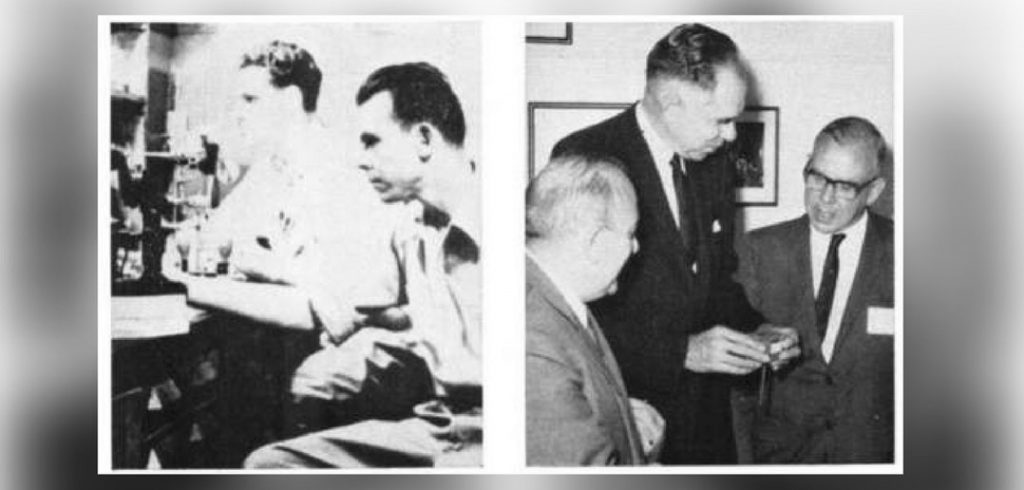Few people have first-hand knowledge that the late Michael Cefola— a distinguished professor emeritus of analytical chemistry and radiochemistry in Fordham’s chemistry department— took part in the historic American-led effort to isolate plutonium.
The radioactive man-made substance would later aid in the development of the atomic bomb. But the accomplished chemist, who died in 1983 at the age of 74, seldom made this scientific breakthrough the topic of discussion, according to those who knew him.
“Mike was quiet, friendly, and not outspoken—which was somewhat different from most of the faculty,” said Richard W. Franck, a former chairman of the chemistry department. “I knew of his important work on the Manhattan Project, but he rarely spoke of it, probably because much of it was classified.”
In commemoration of the 75th anniversary of the isolation of plutonium, Fordham ‘s chemistry department is organizing a mini-symposium to honor Cefola’s contributions to science. The event, which takes place on Wednesday, October 11 from 2:30 p.m. to 5:30 p.m. in Flom Auditorium in Walsh Library on the Rose Hill campus, will honor the work and life of Cefola, who taught at the University from 1950 until 1975.
Preserving the past, looking toward the future
On rare occasions, Diana Bray, a professor emerita who studied analytical chemistry under Cefola during the late ‘60s, said she was among the lucky students who got some insights into his notable role in the Manhattan Project.
She recalled an amusing story he told her class about an “important visitor” who wanted to see the plutonium the team had been working on in the University of Chicago’s Metallurgical Laboratory, a research branch of the Manhattan Project where scientists studied and extracted the new element.
“There was no way on earth they were going to put this very rare element on display for anybody to look at,” said Bray.
Instead, the chemists created a green ink solution and showed it to the prying visitor.
“They went away thinking they had seen the plutonium, and the scientists knew their plutonium was safe,” said Bray. She said that despite his accomplishments, Cefola was “the most humble person you could ever want to meet.”
Cefola’s son Michael Cefola, FCRH ’71, recalls days when Cefola, a staunch Yankees fan, would take him to the Rose Hill campus as child and show him around his laboratory. The Bronx-bred chemist was particularly passionate about helping to develop the next generation of scientists at Fordham, he said.
“At the time, dad was just dad, throwing baseballs in the backyard with me. And other times, he was my father the professor, who was buried in his work and his studies,” he said. “He took incredible pleasure working on the papers of his graduate students.”
Cefola, who immigrated to the United States in 1918 from Barile, Italy, worked alongside some of the world’s greatest scientists in the Chicago-based lab.
“He was a leader in microchemistry and he developed methods for weighing small, microscopic quantities of substances,” said Donald Clarke, a colleague and professor of biochemistry at Fordham.
Nobel Prize winner Glenn Seaborg, chairman of the Atomic Energy Commission, recruited Cefola for the famed Manhattan Project in 1942. The group also included Nobel Prize-winning physicist Enrico Fermi, who built the first nuclear reactor.
“People who are here now don’t often know about the accomplishments of faculty who were here in the past,” said Carla Romney, associate dean for STEM and Pre-Health Education. Romney said the event will commemorate the work of faculty and students in the chemistry department who have helped to sustain Cefola’s legacy over the years.
In addition to featuring Cefola’s former students and colleagues, Romney said the October 11 event will include a reading from Free Ferry, a book of poems by Cefola’s daughter-in-law, Ann Cefola. Using classical mythology, Free Ferry juxtaposes Cefola’s work in nuclear chemistry with the nuclear family.
“Underneath this narrative is the extraordinary story of, and intrigue around, the isolation and weighing of plutonium—a visual ‘undercurrent’ that impacted daily life some 20 years later, in the 1960s,” said Ann Cefola.
For Romney, this event provides a unique opportunity to meld the humanities and the sciences, while creating broader awareness of the little-known contributions that Cefola made in science.
“It’s a notable achievement in chemistry and a great opportunity to bring everyone together.”


